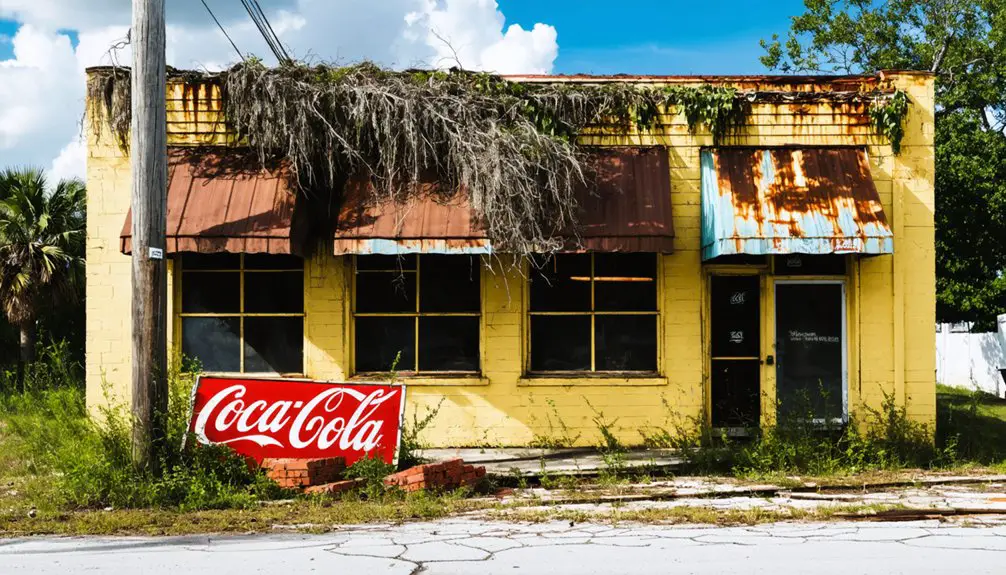You’ll find Gillette ghost town at 27.60111°N, 82.52694°W in Manatee County, Florida. Originally called Frog Creek, this former agricultural settlement thrived in the late 1800s through cattle ranching and citrus farming. Daniel Gillett’s influence led to its name change, marked by the establishment of a post office in 1895. Though the community declined by the mid-20th century, remnants of its Baptist church, founded in 1868, and agricultural heritage await your exploration.
Key Takeaways
- Originally named Frog Creek, Gillette was established in the 1800s as a pioneer settlement focused on cattle ranching and citrus farming.
- The town is located at coordinates 27.60111°N, 82.52694°W, with minimal remaining structures visible today.
- Gillette’s decline began with the closure of its post office in 1910 and continued due to lack of railway connections.
- The First Baptist Church, established in 1868, served as both a religious and educational center for the community.
- Visitors should bring navigation tools and exercise caution, as the ghost town lacks signage and contains hazardous overgrown areas.
From Frog Creek to Gillette: A Name’s Evolution
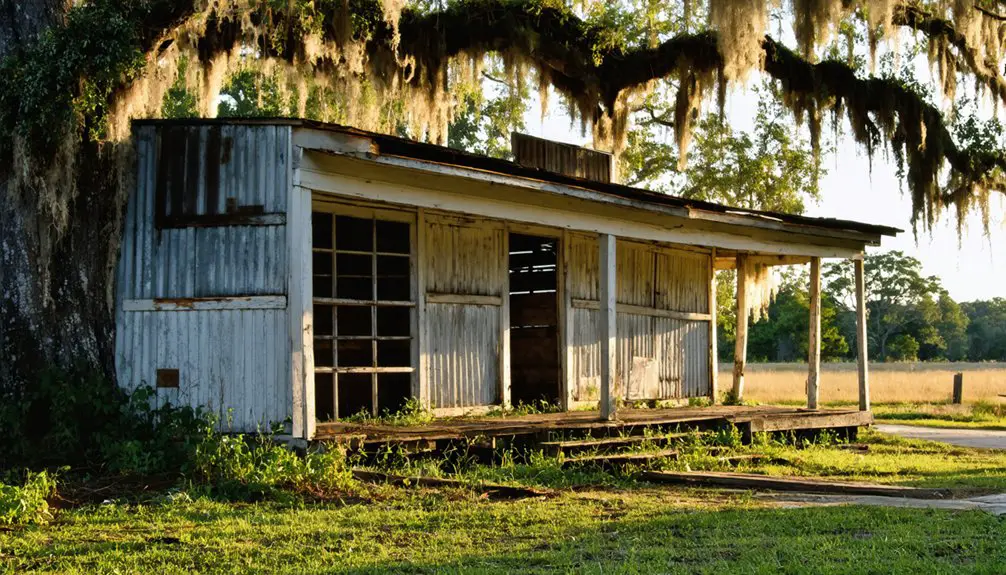
While many Florida communities derived their names from natural features, the evolution of Gillette’s name reflects the profound influence of its early settlers.
You’ll find the area’s original name, Frog Creek, was rooted in the local waterway that defined the landscape during initial settlement. Today, Frog Creek Campground continues to preserve this historical name connection.
The historical significance of this community naming change began with Daniel Gillett, a principal settler whose family’s prominence gradually shaped the area’s identity. The family established themselves in the region during the late 1840s when they first arrived from Georgia.
As his influence grew, you’ll notice the spelling evolved to “Gillette,” becoming formalized when the local post office adopted the name.
The shift from Frog Creek to Gillette wasn’t sudden but rather a natural progression that mirrored the changing dynamics of leadership and settlement patterns in this rural Florida community.
Early Settlement and Pioneer Life
When you look at Gillette’s origins before the Civil War, you’ll find settlers from Northern Florida, Georgia, and Alabama establishing a pioneer community then known as Frog Creek.
You’ll see these early pioneers, led by Daniel Gillett, focusing their efforts on cattle ranching and citrus cultivation, which became the economic foundation of the settlement. Just as the company would later grow to sell 51 razors in its first year, the settlement steadily expanded its agricultural ventures.
The establishment of the area’s first Baptist church in 1850, formally organized in 1868, marked a significant milestone in community development, providing both spiritual guidance and a social center for the growing pioneer population. Much like the safety razor inventor King C. Gillette who would later revolutionize shaving in America, these early settlers were pioneers in their own right, transforming untamed land into a thriving community.
Pre-Civil War Settlers Arrive
As pioneers ventured south in the early 1800s, settlers from Georgia, Alabama, and northern Florida established new lives in what would become Gillette. Among these early arrivals was Daniel Gillett, who’d journeyed from Georgia through Alachua County before settling in the area.
The settler motivations often centered on opportunities in cattle ranching, fishing, and citrus farming, while migration patterns frequently traced back to colonial roots in the Carolinas. Like many families at the time, they endured poverty and destruction following the Civil War. Modern researchers can now explore these early settlement records through digital collection tools that enhance accessibility and preservation of historical documents.
You’ll find these pioneers were remarkably resourceful, adapting to frontier conditions while building self-reliant homesteads.
However, they faced significant challenges, including conflicts during the Seminole Indian wars. The settlement period wasn’t without violence – records show at least one settler lost his life to musket fire on his own porch, highlighting the precarious nature of frontier life.
Agriculture Shapes Pioneer Community
Through diverse agricultural pursuits, Gillette’s pioneers established a thriving community centered on winter vegetables, cattle ranching, and citrus production.
You’d find these early settlers working the fertile lands, growing pioneer crops like pineapples and coontie roots while letting their branded pigs roam freely. They learned valuable cultivation techniques from Seminole tribes, who taught them how to process local plants and identify edible native species. Many settlers faced the same harsh pioneer conditions that George Gillett Keen documented in his reminiscences about early Florida life. The settlers improved their farming success by using seaweed as mulch to enrich the sandy soil.
As the community grew, farming evolved from basic subsistence to commercial endeavors.
You could see packinghouses springing up near railroad depots, enabling farmers to ship their produce to wider markets. Families supplemented their income through truck farming, selling fresh vegetables to neighboring towns while maintaining livestock operations that included dairy cows, chickens, and geese.
Early Religious Foundations Established
Religious foundations took root in Gillette alongside its agricultural development, beginning with the establishment of Gillette First Baptist Church in 1868.
You’ll find that this church served as more than just a place of worship – it became the heart of pioneer social life, hosting community gatherings and early educational activities.
The religious influence shaped Gillette’s physical and social landscape, with the church building standing as one of the settlement’s first permanent structures.
When the post office opened in 1895, it strengthened the growing community’s connections. Like many other Florida communities of the early 1900s land boom, Gillette experienced rapid growth and development during this period.
Many Norwegian immigrants settled in the region, contributing to the area’s cultural diversity and agricultural development.
Church leaders guided both spiritual matters and practical decisions, fostering community cohesion among the settlers.
The congregation’s gathering place doubled as an informal town hall, where residents could strengthen their cultural bonds and make decisions affecting their collective future.
The Legacy of Daniel Gillett
When Daniel Gillett established his settlement in what would become Gillette, Florida, he laid the groundwork for a thriving agricultural community that would shape Manatee County’s development.
His pioneer achievements included introducing cattle ranching and citrus cultivation, while his community influence extended to supporting the establishment of the area’s first Baptist church.
You’ll find Gillett’s enduring legacy reflected in these transformative contributions:
- Attracted settlers from Northern Florida, Georgia, and Alabama, creating a distinct demographic identity
- Developed sustainable agricultural practices adapted to local conditions
- Established the foundation for the first religious institution north of the Manatee River
- Transformed wilderness into a structured rural community through strategic economic activities
His vision and leadership positioned Gillette as a significant settlement in 19th-century Florida’s development.
Agricultural Roots and Economic Foundation
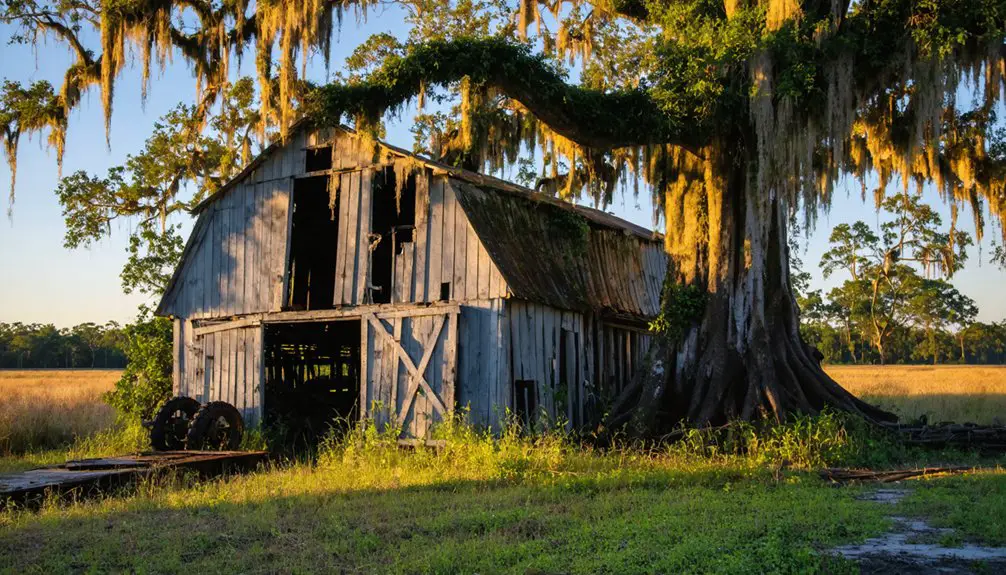
You’ll find that Gillette’s earliest economic cornerstones were firmly established through cattle ranching, with hardy livestock well-suited to Florida’s challenging scrub and marsh terrain.
The community’s agricultural prospects expanded greatly with the introduction of citrus farming, which proved particularly viable given the area’s fertile soil and favorable growing conditions.
While cattle ranching remained a steady source of income for local families, citrus groves became increasingly central to Gillette’s economy, with oranges and other citrus fruits serving both local consumption needs and broader commercial markets.
Cattle Ranching Heritage
The agricultural heritage of Gillette, Florida was deeply rooted in cattle ranching, with Daniel Gillett establishing himself as a prominent cattle rancher both before and after the Civil War.
You’ll find that early settlers from Northern Florida, Georgia, and Alabama brought their ranching traditions to the area, shaping local practices that included cattle branding and ear notching for livestock identification.
The region’s self-reliant spirit thrived through:
- Year-round grazing on natural grasslands without supplemental feed
- Open-range management influenced by Florida Cracker and Seminole traditions
- Community gatherings centered around cattle roundups and auctions
- Preservation of traditional ranch management despite market pressures
These practices helped sustain the community’s economic foundation, supporting local institutions while maintaining a connection to the land that defined Gillette’s identity throughout the 19th and early 20th centuries.
Citrus Industry Development
Following Spanish explorers’ introduction of citrus to Florida in the early 1500s, commercial cultivation near Gillette emerged as a transformative force alongside the region’s established cattle industry.
You’ll find that citrus cultivation took root as railroad development enabled nationwide distribution in the post-Civil War era, despite early challenges from cold weather and inadequate transportation.
Local growers joined the industry’s rapid expansion during the “orange fever” of the 1870s, participating in organizations like the Florida Fruit Growers Association.
While devastating freezes in the 1890s forced many operations southward, scientific innovations and mechanization in the early 20th century strengthened the industry’s resilience.
The economic impact rippled through Gillette’s community, as citrus production complemented cattle ranching to create diverse agricultural opportunities and employment.
Religious and Educational Milestones
During Gillette’s formative years, religious institutions and educational endeavors played pivotal roles in shaping the community’s identity.
In 1850, Manatee County’s first Baptist Church was established in Gillette, initially named Frog Creek Church before becoming Benevolence Baptist Church. This institution served as both a spiritual center and an educational foundation, where community rituals and educational partnerships flourished together.
- The church operated as a dual-purpose facility, hosting both religious services and basic education classes.
- Local volunteer teachers and ministers provided instruction in reading, writing, and arithmetic.
- Religious values were woven into the educational curriculum, reflecting frontier community priorities.
- The church-school partnership created a strong social framework that sustained Gillette’s early development.
Post Office Era: 1895-1910
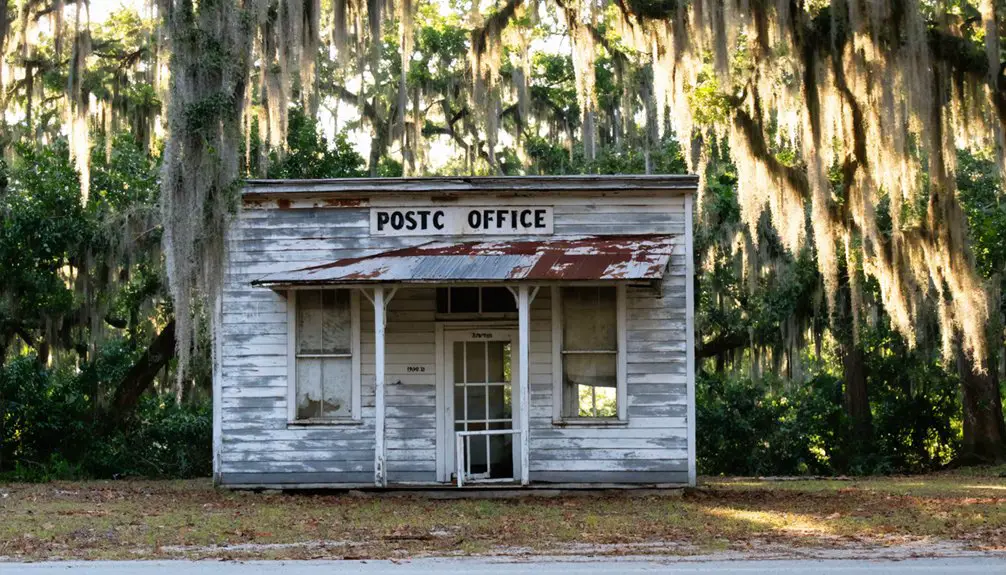
You’ll find that Gillette’s post office, established in 1895 under postmaster Mary Gillett, served as the community’s essential communication hub for fifteen years.
The post office facilitated connections between residents and neighboring settlements like Harwood and Duke, while following established postal protocols including site applications and relocation requests.
Its strategic placement near transportation routes and natural features enhanced mail delivery efficiency until operations ceased in 1910, marking the end of Gillette’s original postal era.
Mail Service Operations
As an essential communication hub for the growing community, the Gillette post office opened its doors in 1895, operating from a centrally located building on Gillette Avenue.
You’ll find that this crucial institution served as the primary link between Gillette’s residents and the outside world, coordinating mail routes and fostering community connectivity during a transformative period in Florida’s development.
The post office’s core services included:
- Processing incoming and outgoing letters for local families
- Handling parcel deliveries for commerce and trade
- Managing government communications and documents
- Coordinating with contracted mail carriers for rural route delivery
Through these operations, you’d have witnessed the post office strengthening local commerce and maintaining critical connections until its closure in 1910, marking the end of an era in Gillette’s history.
Community Hub Impact
From its prominent location on Gillette Avenue, the post office emerged as more than just a mail facility – it became the beating heart of the community between 1895 and 1910.
You’d find residents gathering daily to exchange news and maintain social interactions despite their rural isolation. Working alongside the Benevolence Baptist Church, the post office strengthened community identity and fostered a deep sense of belonging among locals.
The building’s classical revival architecture reflected civic pride while serving as a central landmark.
You could witness the post office’s influence on settlement patterns and local commerce, as it anchored economic activities through postal correspondence and mail-order services.
This essential institution helped sustain Gillette’s social fabric until 1910, leaving an enduring legacy that shaped the town’s development during its most vibrant period.
Daily Life in Rural Manatee County
Life in rural Manatee County revolves around a car-dependent culture, with residents spending an average of 27 minutes commuting between their homes and essential services.
You’ll find that the rural lifestyle centers on family-oriented activities, with churches and community centers serving as social anchors. Most households own two vehicles, reflecting the necessity of personal transportation in areas where public transit is limited.
- You’ll participate in local markets and school events, which form the backbone of community dynamics.
- You can expect to drive significant distances for specialized healthcare and services.
- You’ll likely engage in outdoor recreational activities near rivers and coastal areas.
- You’ll find social connections through church gatherings and agricultural activities, with many residents maintaining small-scale farms that contribute to local food systems.
The Path to Abandonment
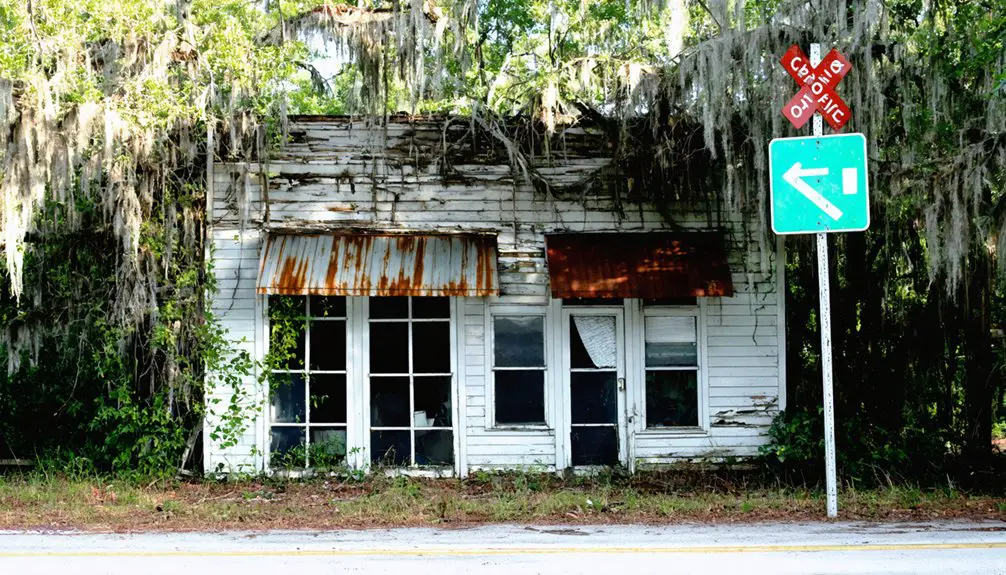
The decline of Gillette began well before its final abandonment, with early warning signs appearing in the town’s infrastructure and demographics.
Signs of Gillette’s looming abandonment emerged early through crumbling infrastructure and shifting population patterns.
You’ll find the first major blow came when the post office closed in 1910, severing an essential communication link to the outside world. Community dynamics shifted dramatically as younger residents left for urban opportunities, leading to the schoolhouse’s closure in 1948.
Economic challenges mounted as the town’s dependency on cattle and citrus proved insufficient for long-term sustainability.
Without railway connections or industrial development, you’d have seen Gillette struggle to compete with better-connected Florida settlements. The lack of diversification in the local economy, combined with deteriorating infrastructure and dwindling population, created a downward spiral that ultimately sealed the town’s fate as residents sought opportunities elsewhere.
Preserved in Historical Records
While many Florida ghost towns fade into obscurity, Gillette’s history remains well-documented through an array of primary sources and official records.
You’ll find its historical significance preserved in church archives, land deeds, and county economic data. From the Baptist church’s founding in 1868 to the schoolhouse’s closure in 1948, these records paint a vivid picture of this once-thriving community’s legacy.
- The Manatee County Library’s digital collections hold photographs and maps that capture Gillette’s transformation from Frog Creek to a bustling agricultural center.
- Church records provide invaluable genealogical data through baptismal and marriage registers.
- Land records trace the evolution of property ownership from Daniel Gillett’s original holdings.
- Tax assessments and economic records document the community’s reliance on cattle and citrus industries.
Visiting the Ghost Town Today

Modern visitors seeking to explore Gillette’s historic grounds will find minimal remnants of its once-thriving community. You’ll need to rely on GPS coordinates (27.60111°N, 82.52694°W) to locate this unincorporated ghost town, as there’s little signage to guide you.
For successful ghost town exploration, you’ll want to come prepared. Bring water, navigation tools, and wear appropriate clothing for Florida’s weather conditions. You won’t find any visitor amenities or dedicated parking areas, so self-sufficiency is essential.
Remember that much of the surrounding area is private property, and the 1925 schoolhouse and other historical structures have long since vanished.
While you’re free to photograph and explore public areas, respect property boundaries and be cautious around any derelict structures or overgrown sections you encounter.
Frequently Asked Questions
Were There Any Notable Crimes or Mysterious Events in Gillette’s History?
You won’t find any documented historical crimes or unsolved mysteries in this town’s records. Its decline was tied to economic factors rather than criminal activity or unexplained events.
What Native American Tribes Originally Inhabited the Gillette Area?
While exact boundaries aren’t certain, you’ll find the Calusa and Timucua tribes contested this region’s tribal history, with Seminoles later arriving. Their cultural significance remains in local shell mounds and artifacts.
Did Any Famous People Ever Live in or Visit Gillette?
Based on available historical records, you won’t find any famous visitors or well-known historical figures who lived in or visited Gillette, except for founder Daniel Gillett, who established the farming community.
What Happened to the Original Buildings and Structures After Abandonment?
Like a forgotten smartphone, most buildings crumbled after abandonment effects took hold. You won’t find much historical preservation – structures either decayed naturally, were relocated, or got demolished for materials over time.
How Many People Lived in Gillette During Its Peak Population Years?
You’ll find that during its peak population years, around 200 people called this place home. Historical significance lies in its typical size for Florida ghost towns before the devastating freezes of 1894-1895.
References
- https://en.wikipedia.org/wiki/Gillette
- https://travelmadepersonal.com/juliette-ghost-town-florida/
- https://www.ocalastyle.com/ghost-towns-of-marion-county/
- https://en.wikipedia.org/wiki/List_of_ghost_towns_in_Florida
- https://cdm16681.contentdm.oclc.org/digital/custom/gillette
- https://mymanatee.contentdm.oclc.org/digital/api/collection/p16681coll2/id/7679/download
- https://www.hmdb.org/m.asp?m=217233
- https://search.sunbiz.org/Inquiry/corporationsearch/SearchResultDetail?inquirytype=EntityName&directionType=PreviousList&searchNameOrder=FROGCREEKCAMPGROUND+H059200&aggregateId=domp-h05920-3719ddab-209b-49fd-aca2-c87a0d3b39e0&searchTerm=FROG+BUILT,+INC.&listNameOrder=FROGBYBEACH+L190001339280
- https://kids.kiddle.co/Gillette
- https://www.sarasotahistoryalive.com/index.php?src=directory&view=history&srctype=detail&back=history
